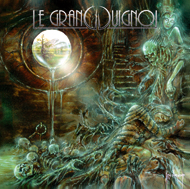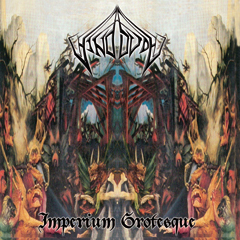 "The Great Maddening" - CD |
|
SPUTNIKMUSIC.COM All too infrequently do we find albums that are so demented that it would seem impossible, inconceivable to accept them as music. Yet, those albums that do defy the odds, that do become the very paradox their creators intended them to be, border on perversion so much so that they cross into the realm of brilliance. Were it not for the fact that we encounter perfection so rarely, we would be quick to recognize this album’s magnificence. Perfection is, however, such a foreign concept that those who are so fortunate as to bear witness to it are unable to comprehend it. This incomprehension leads to frustration, and ultimately, a loss of sanity. It would seem the members of Le Grand Guignol possess a great understanding of this concept as they, so appropriately, titled their debut The Great Maddening. The eccentricities quickly become evident in the very first moments of the album with the instrumental track “Cirqvs L” in which ominous trumpets give way to a very symphonic intro. The next track, “Degenesis”, expands upon the previously established orchestral mastery with beautiful piano melodies underneath a superb guitar solo and the hellishly-theatrical screams of Philip Breur. One of the highlights of the album, “Dimension Canvas” enters with another piano intro accompanied by Breuer’s outstanding harsh vocals. Once again, a menage a trois of piano, guitar and harsh vocals compose the climax of the song, this time with Breuer’s ungodly, ear-bleeding shrieks which inspire thoughts of those cries only heard in asylums. An even more substantial loss of lucidity is more evident in next track than in the previous as “Mens Insana in Corpore Insano” begins with a ghoulishly-perverted half-whispered, half-sung hint of disturbia. The synths in this track are nothing short of phenomenal as they drive the circus-meets-the-renaissance atmosphere and Breuer’s psychotic ringmaster persona. The track ends with a symphonic build up coupled with neo-classical guitar melodies and some electronic vocal foreplay topped off with a sinister cackle from Breuer. “Madness and Her Thousand Young” picks up where “Mens Insana in Corpore Insano” left off with a plethora of unsettling laughs from various maniacal voices followed by beautiful, operatic female vocals sung in the undertones of Breuer’s harsh vocals. As the pace of the song quickens, one of the most orgasmic moments of the album begins, as awe-inspiring guitar harmonies are played over the ever-present synth’s ode to the music of the Renaissance. A sense of urgency in the momentum of the orchestra quickly takes the listener to the final minute of the song where another set of gorgeous guitar harmonies lead in the next track. With arguably the best intro of any track on the album, “The Healing Process” enters with a choir singing behind an elegant lute intro that seems as though they would have been last heard four or five centuries ago in the ballrooms of the Palace of Versailles. This nostalgic illusion soon disappears, however, as the synths introduce a futuristic mood to the song. The last five tracks of the album
reciprocate the theme of the first half: intertwining both old
and new vocalization and instrumentation in the epic, eclectic
atmospheres unique to avant garde metal. Needless to say, The
Great Maddening is nothing short of one of the most astounding
displays of vocal skills, musical technicality and versatility,
production, and most importantly, creativity and imagination
in any genre of music today. It is so perfect because it is
so imperfect, so sound that it’s preposterous. The Great
Maddening is a classic because it repeatedly drowns in the mire
of self-contradiction yet maintains a sense of balance and integrity
that no other album could. |
|
